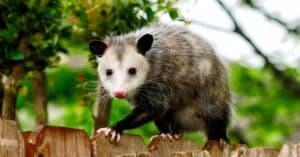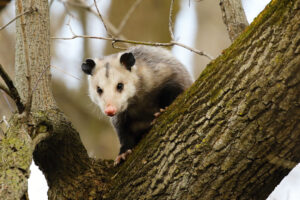Opossums are the only marsupial endemic to the Americas. There are over 120 species of opossum worldwide, but only one species makes the United States and Canada its home: the Virginia opossum. These nocturnal, cryptid creatures have a reputation for playing dead and scrounging for food in urban areas. Here, we’ll explore everything there is to know about opossum teeth, including how they use their teeth for self defense.
How Many Teeth Do Opossums Have?
Virginia opossums have the most teeth of any terrestrial North American mammal. Would you believe that they can fit fifty teeth in their mouth? Opossums may be no bigger than a cat or a small dog, but they’ve got big mouths full of teeth, and they’re happy to use them to eat just about anything they can get their paws on.
Opossums, like humans, go through two sets of teeth in their lifetime. The first set, the deciduous or ‘milk’ teeth, are reabsorbed into the jaw within the first few months of life. Then, the adult teeth start to grow in. Opossums have all of their adult teeth fully developed by the time they’re about six months old.
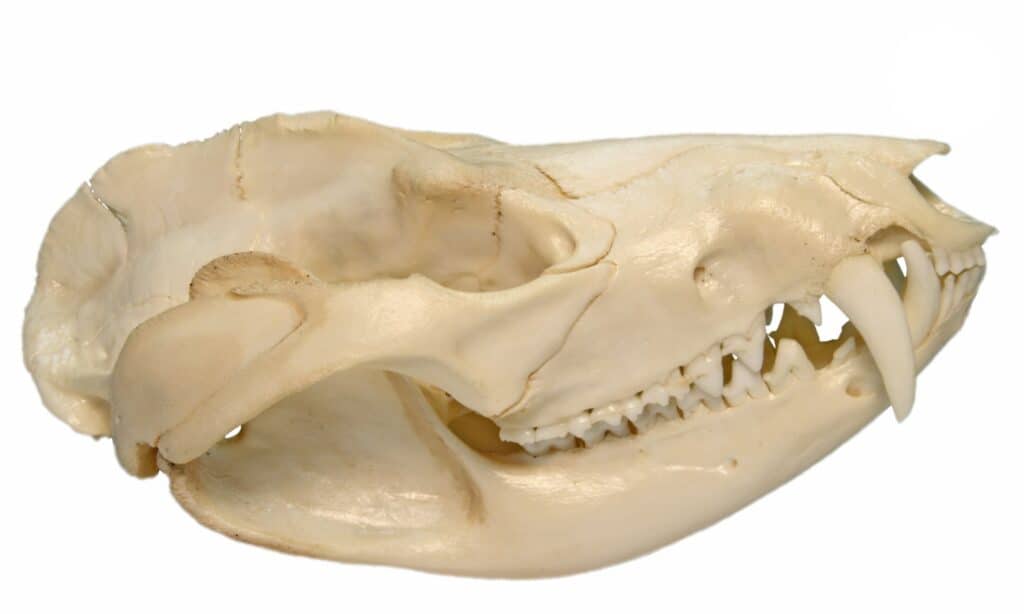
Opossums have 50 teeth – that’s more than any other terrestrial mammal in North America
©Ryan M. Bolton/Shutterstock.com
Incisors
Opossums have 50 teeth, 18 of these are incisors. In mammals, incisors are the teeth located at the very front of the mouth. Opossums have ten maxillary (top) incisors, and eight mandibular (bottom) incisors. The incisors are all very small, and can even be difficult to see in the open mouth of an opossum. These teeth are used primarily for grasping and pulling food–like leaves or insects–into the mouth.
Canines
Even though opossums are omnivores, and rarely hunt anything bigger than a snake–they have an impressive set of canine teeth. Like dogs and cats, opossums have two canines on the top and two on the bottom, with two on each side of the mouth. Opossums have a varied diet, and will eat just about anything that presents itself, including carrion, insects, and small animals. It’s when the opossum hunts that the fearsome canine teeth come into play. Later, we’ll learn what else opossums use their oversized canines for.
Premolars
Opossums have a small gap called a diastema between the canine teeth and their first premolar. They have 12 total premolars; six on the top and six on the bottom, with six on each side of the mouth. The premolars have a single cusp (point) and are instrumental in the chewing process.
Molars
The final teeth in the opossum’s mouth are the molars. Opossums have 16 molars; eight on the top, eight on the bottom, and eight per side. The molars are known as ‘tricuspids’, because they each have three cusps, or tips, with a flat area called a ‘basin’ in the middle of the tooth. When an opossum chews, the cusps on the bottom molars interlock with the cusps on the top molars, providing an excellent cutting and masticating surface.
Do Opossums Bite?
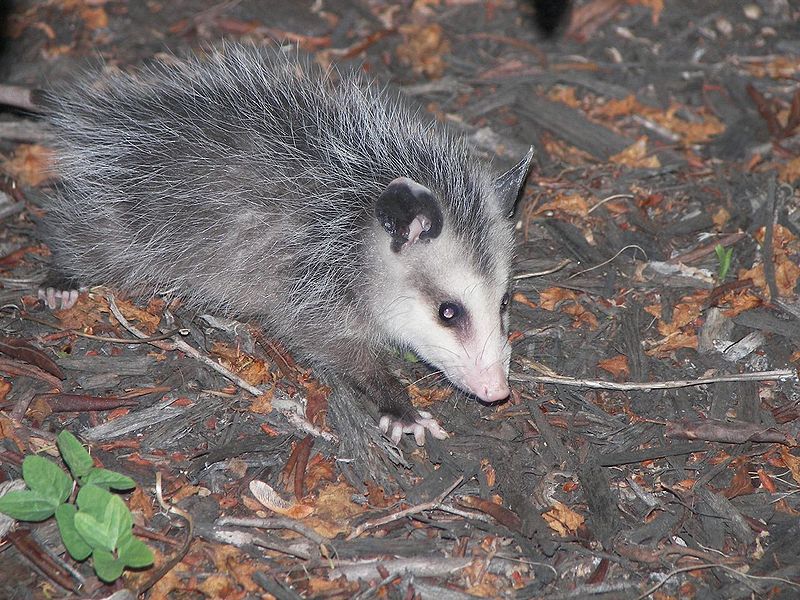
Opossums are shy creatures, and prefer to avoid conflict
Opossums are nocturnal, and prefer to stay out of conflict. They’re what’s called a ‘cryptid’ species–meaning they would rather hide than flee or attack. Still, opossums frequently come into contact with humans, and some of their defense mechanisms can leave people worried about bites.
But, here’s the good news: opossums are non-aggressive, and very rarely bite humans. They may look scary when they open their mouths, but opossums will only bite as a last resort. The best way to avoid getting bitten by an opossum is to never handle them by hand; if you must handle them, be sure to wear gloves, and limit contact as much as possible.
Teeth as Defense
In addition to using their teeth to hunt, scavenge, and chew up their food–opossums also make use of their mouths in self defense. It might seem a little counter intuitive; a non-aggressive animal that uses its teeth in defense, but not to bite?
Let’s take a closer look at the various ways opossums use their teeth to scare off would-be predators–humans included.
Playing Possum
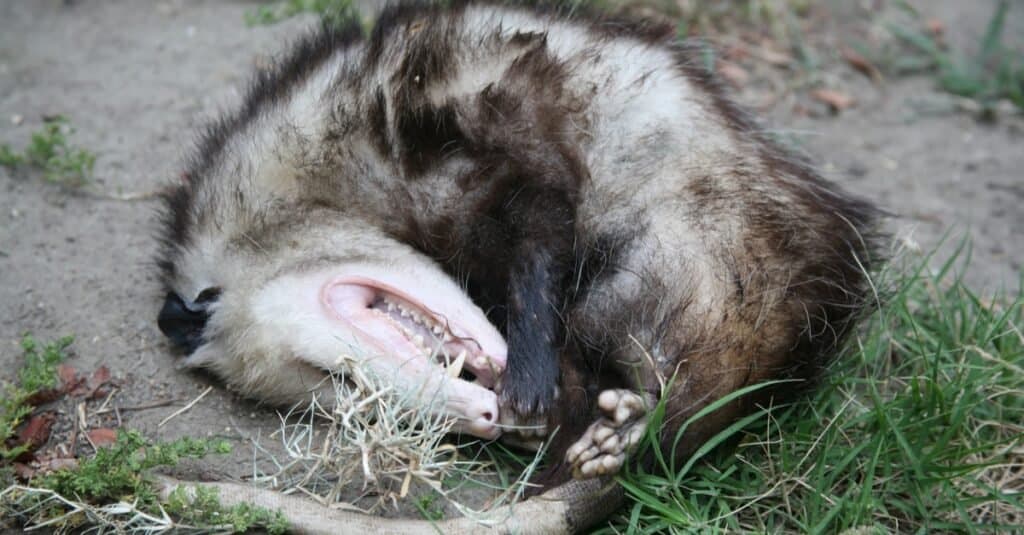
When opossums play dead, they pull their gums back from their teeth to mimic the effects of death
©iStock.com/ScrappinStacy
The opossum’s most famous method of defense is ‘playing dead’. When an opossum sees or hears a potential threat, its first option is often laying down, curling in a ball, and pretending to be dead. But just what do teeth have to do with this?
Well, an opossum’s teeth are vital in the ‘playing possum’ act. When the opossum curls into a ball, it also draws its gums up over its teeth, exposing them all the way from the incisors to the molars. This mimics the appearance of a dead opossum, whose dried out gums would naturally pull away from the teeth. So, by showing its teeth like this, the opossum furthers its ‘dead’ disguise.
Drooling
Another method opossums use to put off predators is drooling. Yes, drooling. This may not seem like a great way to get a predator to leave you alone–but opossums have figured out that if a predator sees a heavily drooling animal, it will more often then not think that animal is sick, and leave it alone.
To effect this drooling, the opossum moves its jaws from side to side and up and down, which stimulates its salivary glands. Once its moved its mouth around enough–out comes the drool and, hopefully, away goes the predator.
Alligator Teeth
Finally, if drooling or playing dead don’t work, the opossum may employ an expression opossum organizations call ‘alligator teeth’. This is when the opossum faces off the predator, draws its gums back, and shows off its ferocious teeth. It may even hiss or growl at the threat; but remember–the opossum’s bark is worse than its bite. Alligator teeth are just for show, but because of their huge canines and fearsome look–this method often enables the opossum to get away and live another day.
The photo featured at the top of this post is © iStock.com/rexlis
Thank you for reading! Have some feedback for us? Contact the AZ Animals editorial team.




